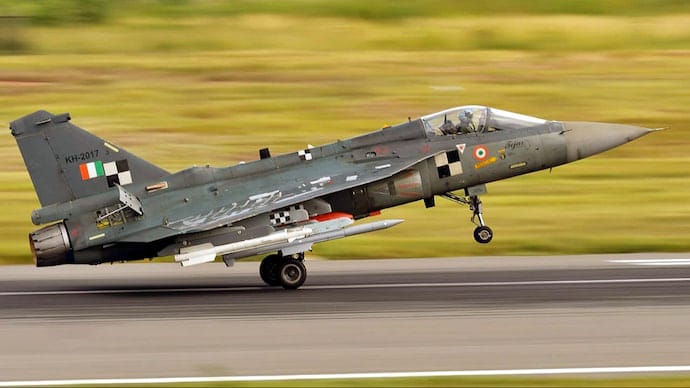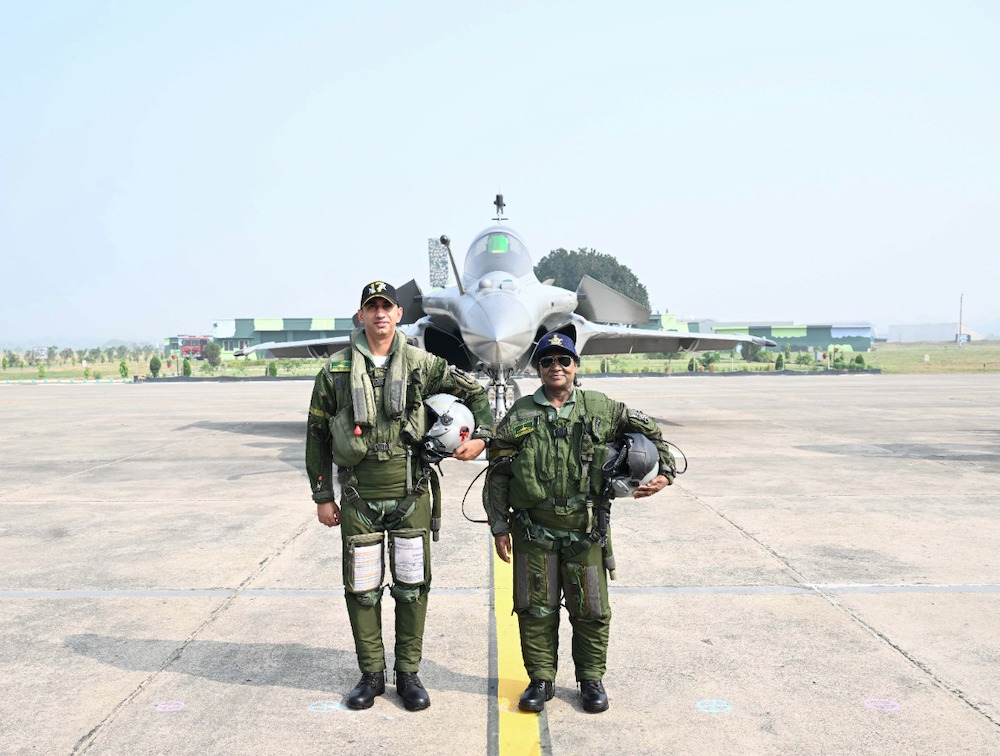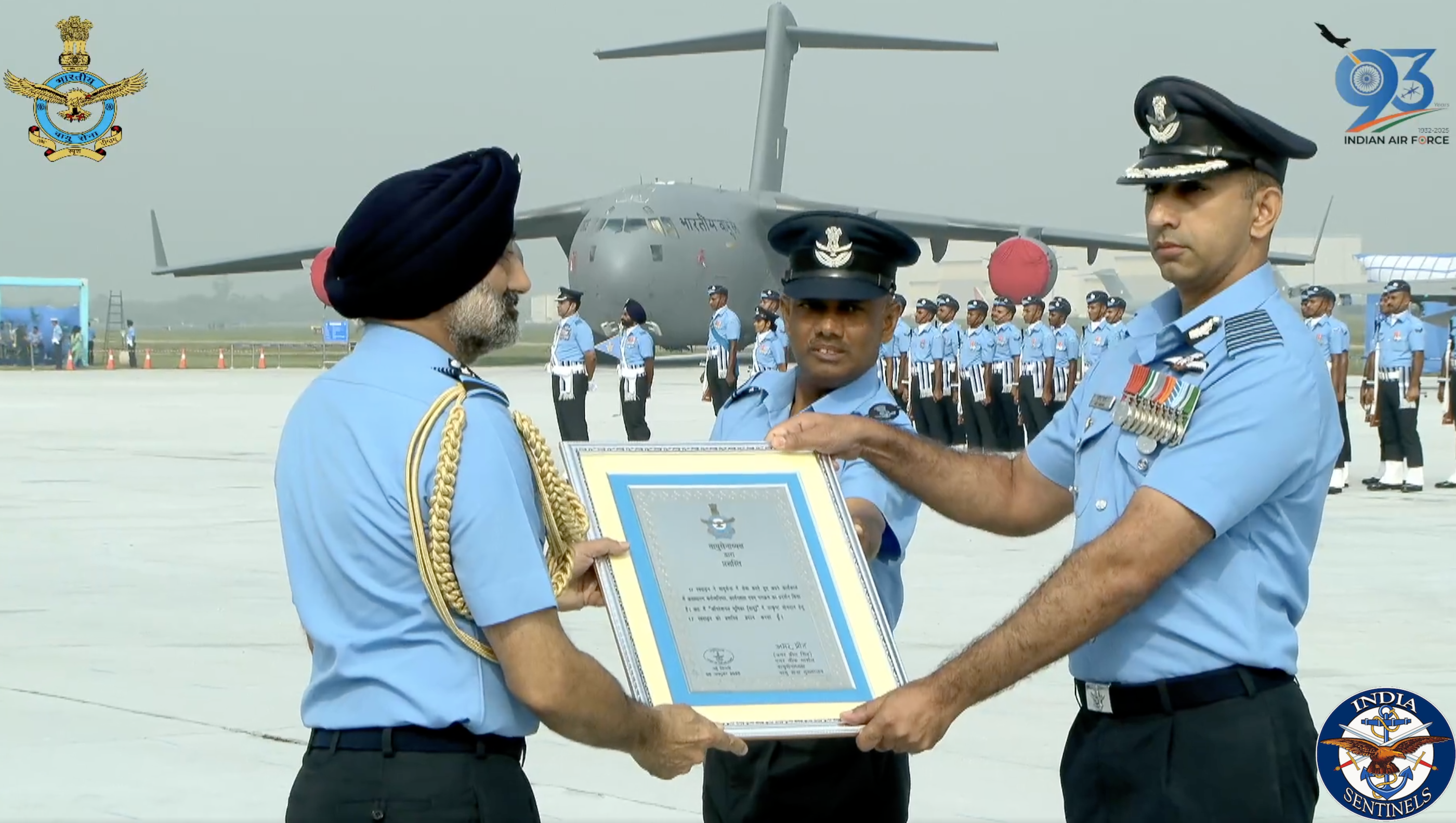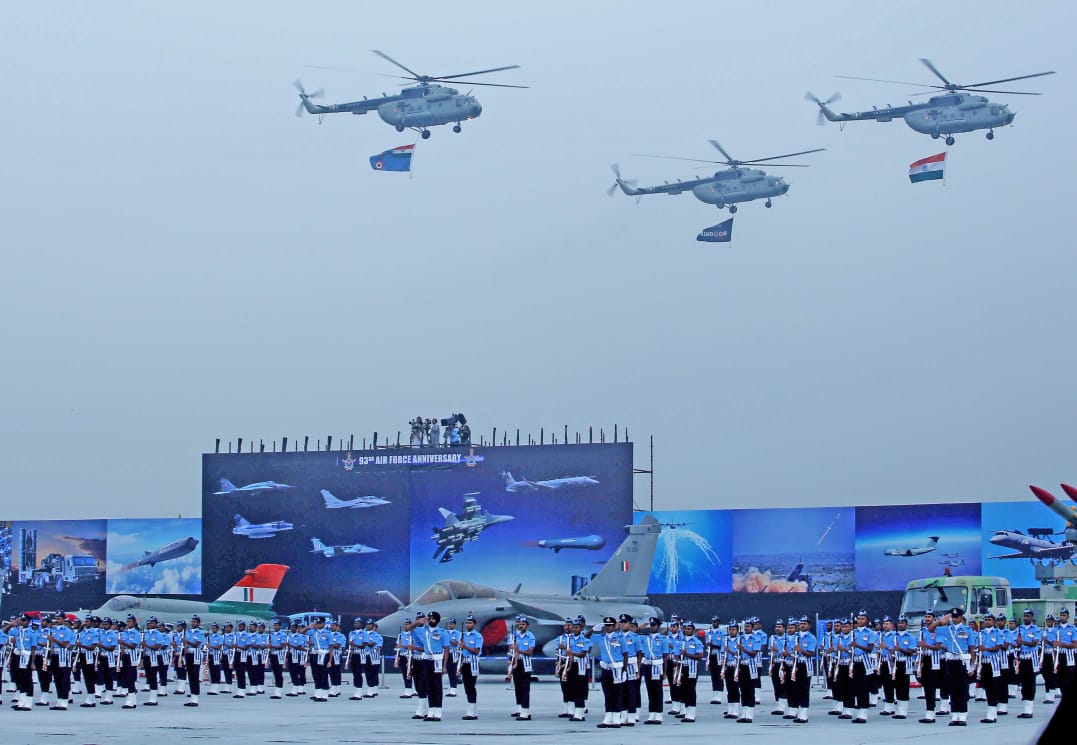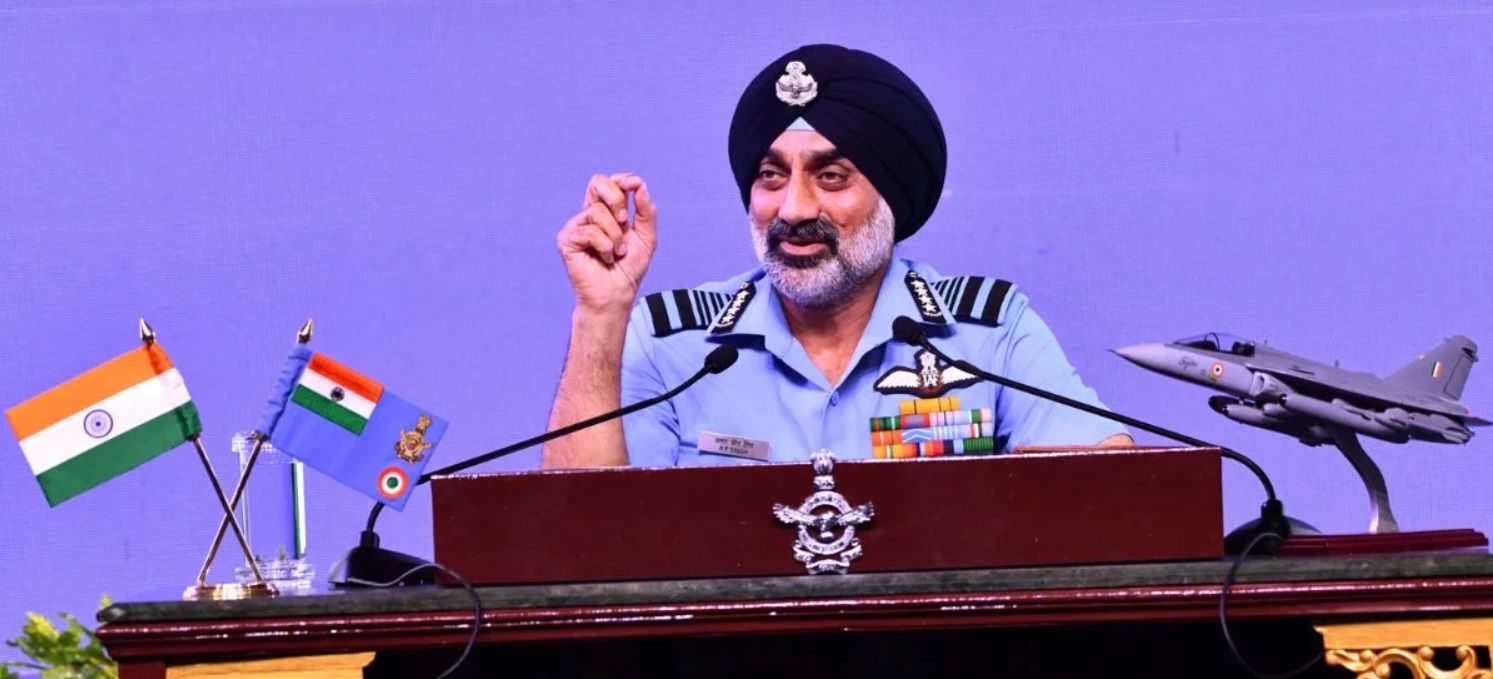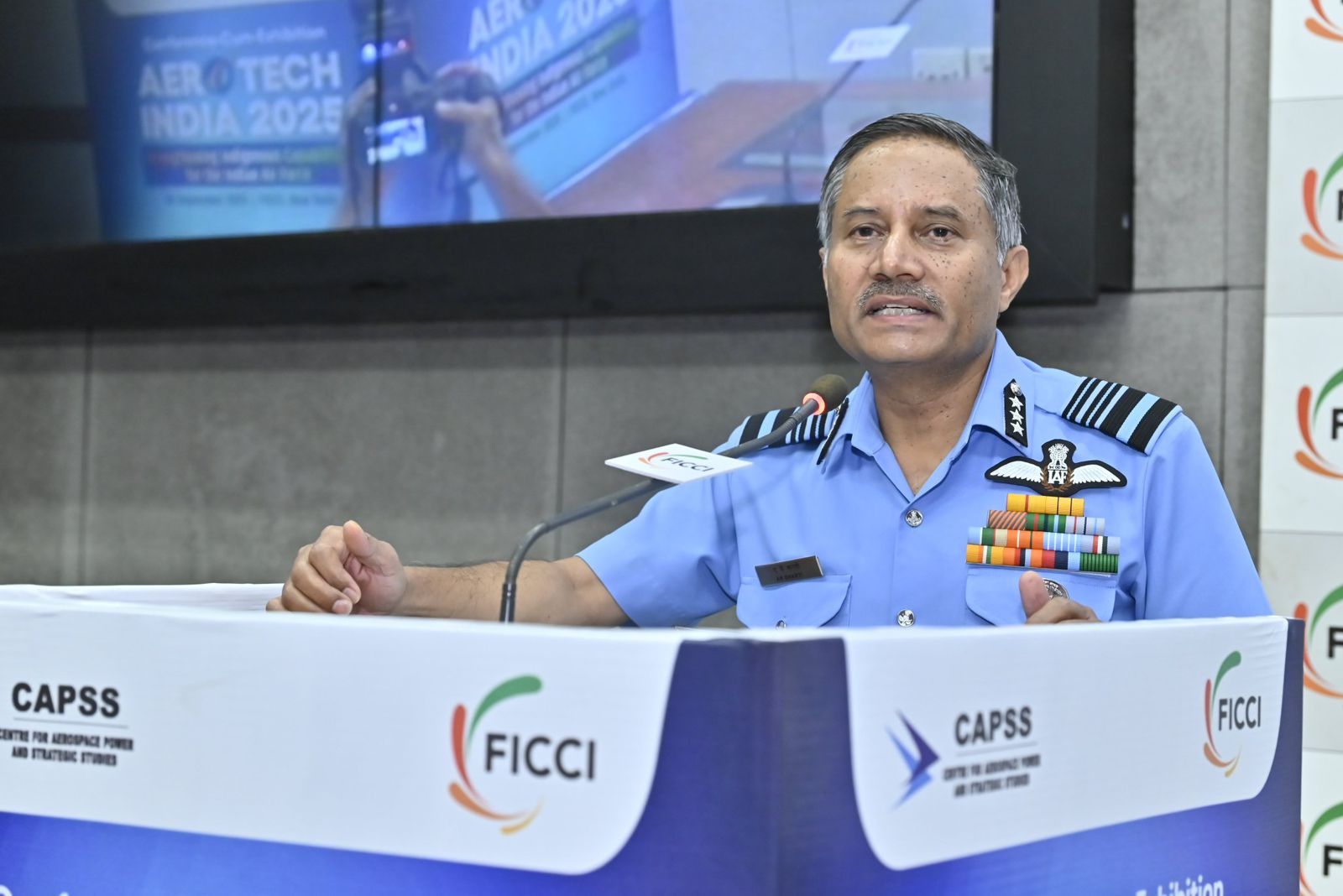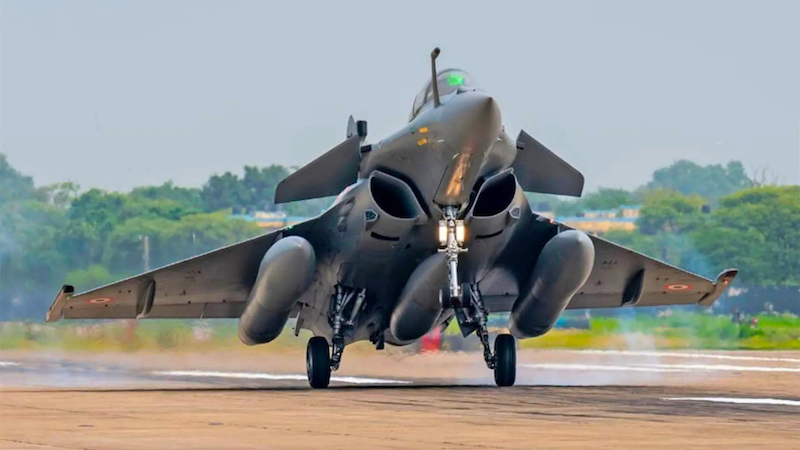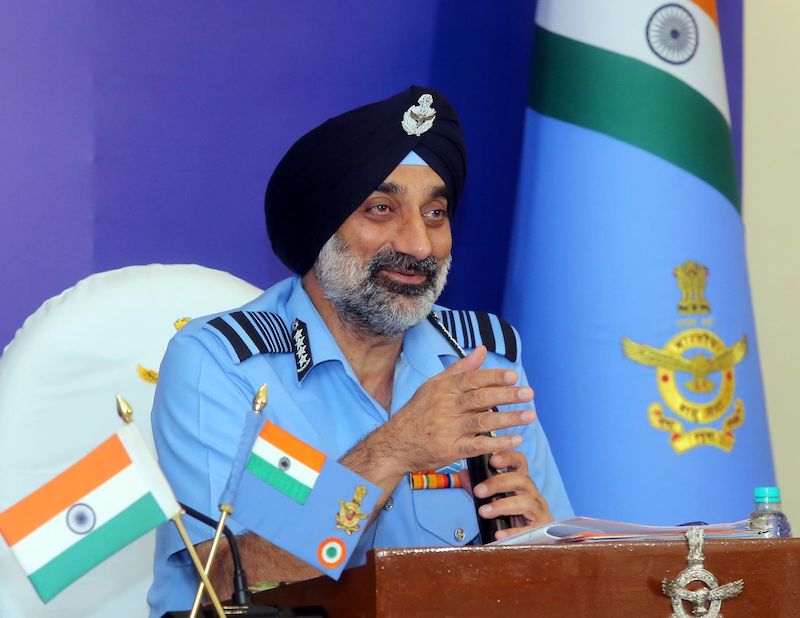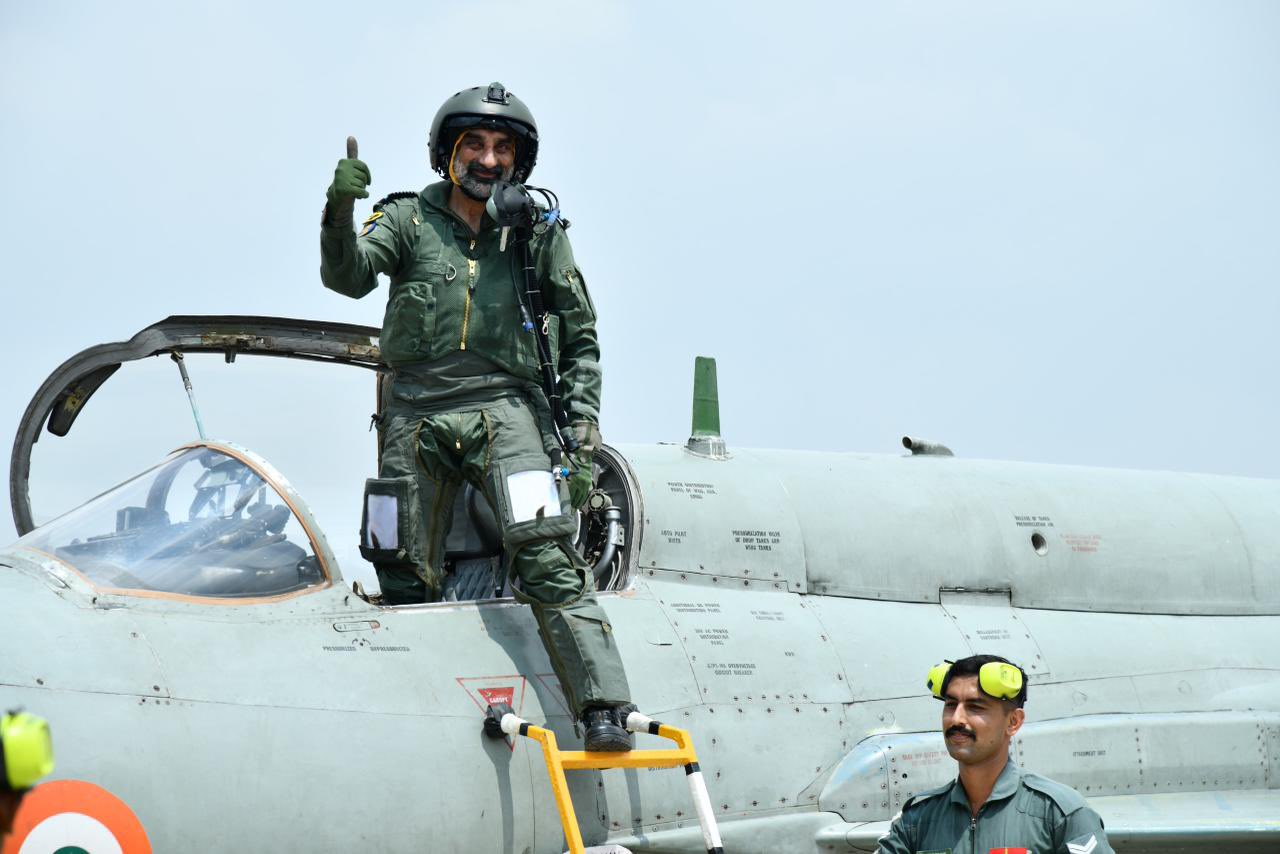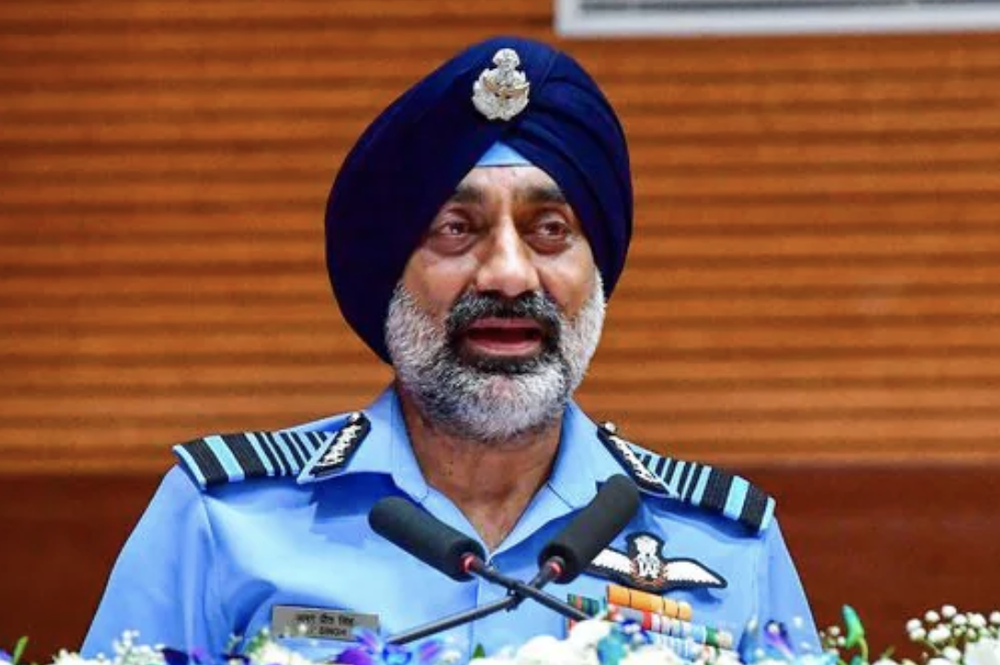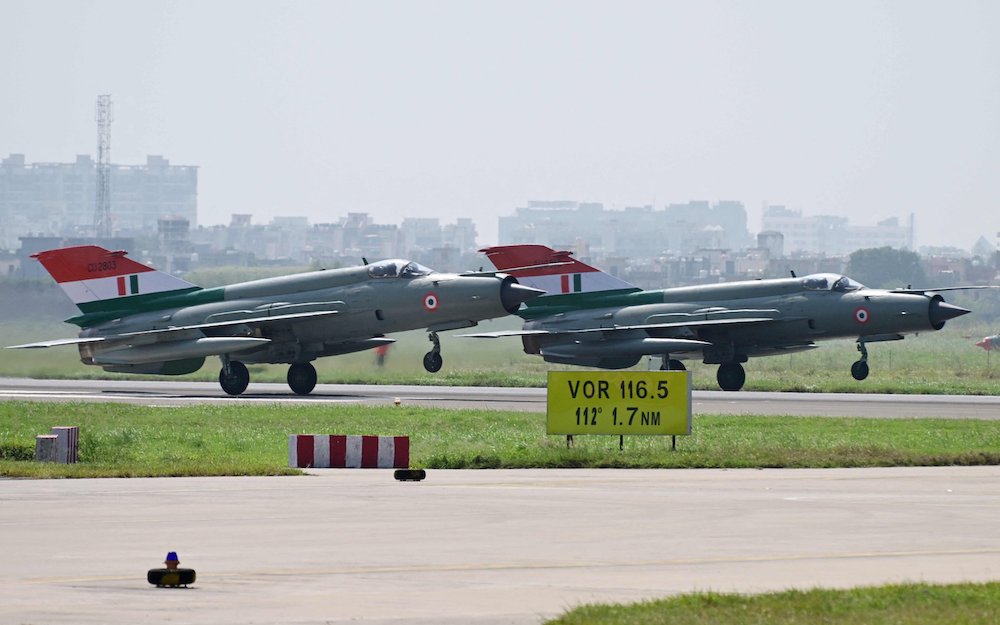 Two MiG-21s take off for the final time at the Chandigarh Air Force Station.
Two MiG-21s take off for the final time at the Chandigarh Air Force Station.
Chandigarh/New Delhi: The Indian Air Force on Friday bid an emotional farewell to one of aviation history’s most iconic fighters – the MiG-21 – bringing down the curtain on 62 years of service that transformed India’s air power and shaped generations of pilots.
In a poignant ceremony at Air Force Station Chandigarh, the same base where India’s first supersonic fighter jets arrived in 1963, the final chapter of an extraordinary aviation story closed. The retirement marks the end of an era for the aircraft that became as much a symbol of national pride as it was a source of controversy.
MiG-21’s journey
The MiG-21’s journey to India began against the backdrop of the Cold War and the nation’s quest for military modernization. In 1961, the Indian Air Force made a pivotal decision to purchase the MiG-21 over several Western competitors, marking a significant shift in India’s defence partnerships. The Soviet Union’s offer included full technology transfer and rights for local assembly – a deal that would prove transformative for India’s aerospace capabilities.
The first batch of eight IAF pilots was selected in October 1962 for training in the Soviet Union. Wing Commander Dilbagh Singh, Squadron Leader MSD Wollen and Squadron Leader SK Mehra, and Flight Lieutenant AK Mukherjee, Flight Lieutenant HS Gill, Flight Lieutenant AK Sen, Flight Lieutenant Denzil Keelor, and Flight Lieutenant Brijesh Dhar Jayal formed this pioneering group. Their training began at Lugovaya airbase in Kazakhstan in the harsh winter of 1962-63, where temperatures plummeted to –20-degrees celsius.
Air Marshal (retired) Brijesh Dhar Jayal, now 90 and among the last surviving members of this historic batch, vividly recalls that transformative moment. “For the first six weeks, we didn’t even see the aircraft. We were immersed in learning Russian and studying the MiG’s systems in detail,” he remembered. On that fateful January morning in 1963, as Jayal climbed into the MiG-21 cockpit for his first solo flight, thundering down the runway at 300kmph, he knew it was “the beginning of a lifelong bond”.
The first six MiG-21F-13s arrived in India in March 1963, initially assembled in Mumbai by Soviet technicians before being flown to Chandigarh. On March 23, 1963, No. 28 Squadron IAF was officially raised at Air Force Station Chandigarh under Wing Commander Singh’s command, earning the immortal nickname “The First Supersonics” – a designation they retain to this day.
Technical marvel
The MiG-21, designated by its Nato reporting name “Fishbed”, represented a quantum leap in fighter technology for India. Designed by the Mikoyan-Gurevich Design Bureau in the 1950s, it embodied the Soviet philosophy of creating a simple, robust, and effective interceptor capable of Mach 2+ speeds.
The aircraft’s delta-wing configuration gave it exceptional climbing performance and speed, with the ability to ascend at over 250 metres per second in maximum reheat. Its compact design – measuring just 15.76 metres in length with a wingspan of 7.15 metres – housed a powerful Tumansky turbojet engine that evolved through various iterations, from the initial R-11F-300 to the more powerful R-25 in later variants.
The MiG-21’s technical specifications were impressive for its era: a maximum speed of Mach 2.05, service ceiling of 60,000 feet, and combat radius sufficient for India’s defensive needs. However, these capabilities came with inherent challenges. The aircraft’s high landing speed of 340kmph – the highest in the world – demanded exceptional piloting skills.
India’s relationship with the MiG-21 deepened through technology transfer agreements that allowed Hindustan Aeronautics Limited (HAL) to manufacture the aircraft under licence. Between 1963 and the early 2000s, HAL produced 657 MiG-21s across various variants, making India the largest operator of the type outside the Soviet Union. This local production capability became the foundation of India’s aerospace industry, providing invaluable experience that would later enable indigenous programmes like the Tejas.
Evolution through variants
The MiG-21’s six-decade service in India encompassed multiple variants, each representing technological advancement and operational refinement. The initial MiG-21F-13 (Type 74) served as India’s introduction to supersonic flight, followed by the MiG-21PF (Type 76) which introduced radar capability. The MiG-21FL (Type 77) became the backbone of the fleet during the 1971 war, while the MiG-21M (Type 96) and MiG-21bis (Type 75) brought enhanced multi-role capabilities.
The crowning achievement of the MiG-21’s evolution was the Bison upgrade programme initiated in the 1990s. Faced with delays in the indigenous Light Combat Aircraft programme and the aircraft’s approaching obsolescence, India embarked on a comprehensive modernization effort with Russian assistance. The MiG-21 Bison incorporated advanced avionics including the Phazotron Kopyo pulse-Doppler radar, beyond-visual-range R-77 missiles, and modern electronic warfare systems.
The Bison upgrade effectively transformed the 1960s airframe into a 21st-century fighter. The first upgraded aircraft flew in 2001, and the programme ultimately modernized 125 aircraft, extending their service life by over two decades. Despite its age, the upgraded Bison proved competitive against much newer aircraft in exercises, testament to its sound basic design and the effectiveness of the modernization package.
Baptism by fire
The MiG-21’s combat debut came during the 1965 India-Pakistan War, though its role was limited due to small numbers and ongoing pilot training. With only a handful of aircraft operational, the MiG-21s flew defensive sorties but gained valuable experience that would prove crucial in future conflicts.
The 1971 Bangladesh Liberation War marked the MiG-21’s coming of age as a combat aircraft. With eight squadrons now operational, the type played a decisive role in achieving air superiority. The aircraft’s most famous mission came on December 14, 1971, when MiG-21s conducted a precision rocket attack on the governor’s house in Dhaka. The accuracy of the strike so unnerved the Pakistani leadership that the governor, Malik, immediately resigned and fled. Pakistan’s surrender followed just two days later, with 93,000 troops laying down their arms.
The MiG-21’s combat record in 1971 was impressive: it claimed four Pakistani F-104A Starfighters, two F-6s (Chinese-built MiG-19s), one F-86 Sabre, and one C-130 transport aircraft. The first supersonic air combat in the subcontinent occurred when an Indian MiG-21FL downed a PAF F-104A with its GSh-23 twin-barrelled 23mm cannon. According to Western military analysts, the MiG-21FL had clearly “won” the much-anticipated contest against the F-104A Starfighter.
The 1999 Kargil War demonstrated the MiG-21’s continued relevance three decades after its induction. Operating under the codename Operation Safed Sagar, MiG-21s flew alongside newer aircraft in the challenging high-altitude environment. The conflict tragically claimed Squadron Leader Ajay Ahuja, whose MiG-21 was shot down by a Pakistani shoulder-fired missile while searching for a downed colleague.
Modern glory
The MiG-21’s most celebrated modern hero is Group Captain Abhinandan Varthaman (then Wing Commander), who achieved the aircraft’s final air-to-air victory on February 27, 2019. During the aerial engagement following India’s Balakot airstrike, Varthaman’s MiG-21 Bison shot down a Pakistani F-16 – a remarkable achievement considering the technological generation gap between the two aircraft. Although his own aircraft was subsequently hit, forcing him to eject in enemy territory, Varthaman’s victory demonstrated that in skilled hands, even an aging MiG-21 could triumph over much newer opponents.
The significance of Varthaman’s achievement extends beyond the immediate tactical success. His citation for the Vir Chakra noted his “exceptional air combat acumen” in detecting and engaging an enemy aircraft attempting to ambush Indian formations. Even after being captured, he maintained his dignity and composure, embodying the highest traditions of the IAF.
The aircraft also participated in Operation Sindoor in 2025, its final operational deployment. This mission demonstrated the MiG-21’s continued utility even as newer platforms like the Rafale and Tejas entered service.
The dark shadow
Despite its combat successes and technological achievements, the MiG-21’s legacy is overshadowed by a troubling safety record that earned it the infamous sobriquet “flying coffin”. Since its induction in 1963, more than 400 MiG-21s have crashed, claiming the lives of over 200 pilots and approximately 60 civilians. The aircraft’s accident rate peaked during the 1980s and 1990s, with approximately one crash per 10,000 flying hours.
The reasons behind this high accident rate are complex and multifaceted. The MiG-21’s demanding flight characteristics, particularly its high landing speed and unforgiving nature at low speeds, required exceptional pilot skill. The aircraft’s design prioritized performance over safety margins, typical of Soviet-era philosophy that emphasized operational capability over pilot survivability.
Maintenance challenges compounded the safety issues. As the Soviet Union ceased MiG-21 production in 1985, India struggled to source quality spare parts, often resorting to second-hand components from Israel and Ukraine. The aging airframes, some of which had exceeded their designed service life by decades, became increasingly prone to structural failures and system malfunctions.
Aviation historian Anchit Gupta highlighted a critical flaw in the IAF’s use of the MiG-21 as both a combat aircraft and advanced jet trainer. The absence of dedicated advanced jet trainers (AJTs) forced rookie pilots to transition directly to the demanding MiG-21, exposing them to its unforgiving characteristics before they had developed the necessary skills and judgement.
The human cost of these accidents cannot be understated. Squadron Leader Meet Kumar’s death in 2018 particularly highlighted the tragedy, as he had previously praised the MiG-21 in an IAF promotional video, calling it a “beautiful machine” and describing the bond between pilot and aircraft as “very rare”. His death in a crash near Kangra epitomized the bittersweet relationship between the IAF and its longest-serving fighter.
Industrial legacy
The MiG-21’s contribution to India’s aerospace capabilities extends far beyond its direct military service. HAL’s experience in manufacturing 657 aircraft under licence provided invaluable technological knowledge that became the foundation for subsequent programmes. The infrastructure, skills, and industrial base developed for MiG-21 production directly enabled India’s later success in manufacturing Sukhoi-30MKIs and developing indigenous aircraft like the Tejas.
The technology transfer agreements associated with the MiG-21 programme represented one of India’s earliest and most successful efforts at absorbing foreign aerospace technology. The experience gained in manufacturing engines, avionics, and airframes under Russian guidance provided Indian engineers and technicians with crucial expertise that would prove invaluable in later projects.
Moreover, the MiG-21 served as a training platform for nearly 2,000 IAF pilots over its six-decade service. This massive pool of supersonic-trained aircrew formed the backbone of India’s fighter pilot community, with many rising to senior positions and contributing to the IAF’s institutional knowledge and capability development.
Global impact
The MiG-21’s significance extends beyond India’s borders. As the most-produced supersonic fighter in history, with over 11,000 aircraft manufactured, it served in approximately 60 countries across four continents. India’s operation of 872 aircraft made it the largest operator outside the Soviet Union, and its long service record provided valuable data on the type’s capabilities and limitations.
India’s success with the MiG-21 led to requests for pilot training from other nations. By the early 1970s, more than 120 Iraqi pilots were being trained by the IAF, demonstrating international recognition of Indian expertise with the aircraft. This early example of defence cooperation helped establish India’s credentials as a reliable partner in military aviation.
The MiG-21’s combat record in Indian service also influenced global perceptions of the aircraft. Its victories over Pakistani F-104 Starfighters in 1971 helped restore the type’s reputation, which had been tarnished by poor performance in Arab hands during Middle Eastern conflicts. The IAF’s professional operation of the aircraft demonstrated that with proper training, maintenance, and tactics, the MiG-21 could be highly effective.
The final curtain
Thursday’s retirement ceremony at Chandigarh represented more than just the end of an aircraft’s service – it marked the conclusion of an era in Indian military aviation. The ceremony featured the final flights of the remaining two squadrons: No. 3 “Cobras” and No. 23 “Panthers,” both operating the Bison variant.
In a symbolic gesture, the aircraft’s Form 700 – the official maintenance document serving as its logbook – was handed over to the chief guest, representing the MiG-21’s final closure in service records. Veteran pilots and crew members who worked with the aircraft over its 62-year journey attended, providing living links to the aircraft’s remarkable history.
Air Chief Marshal Amar Preet Singh’s farewell sorties in August 2025 at Nal Air Force Station provided an emotional conclusion to the MiG-21’s active service. Flying alongside Squadron Leader Priya, one of the IAF’s women fighter pilots, the air chief’s final flights symbolized both tradition and transformation – honouring the past while embracing the future.
As Singh noted after his final MiG-21 sortie, “Everything has a time and place. The technology is now outdated and difficult to maintain. It’s time to move to newer platforms like the Tejas, Rafales and Su-30s”. This pragmatic assessment captures both appreciation for the MiG-21’s service and recognition that military aviation must continue evolving.
Challenges ahead
The retirement also highlights the IAF’s modernization challenges. With the MiG-21’s departure, the IAF’s fighter squadron strength drops to 29 from the sanctioned 42, creating capability gaps at a time when India faces threats from both China and Pakistan. The indigenous Tejas Light Combat Aircraft, intended as the MiG-21’s successor, has faced delays that forced the IAF to continue operating the aging fighters far beyond their intended service life.
The squadron strength issue remains a pressing concern for India’s defence planners. With China rapidly modernizing its air force and Pakistan maintaining a credible aerial threat, the reduction in squadron numbers poses strategic challenges that will require urgent attention in the coming years.
An enduring legacy
The MiG-21’s retirement closes one of the most remarkable chapters in military aviation history. From its arrival as India’s first supersonic fighter to its final operational sorties, the aircraft served as both the backbone of Indian air power and a symbol of the nation’s defence aspirations.
Its combat record – from the 1971 liberation of Bangladesh to the 2019 Balakot operations – demonstrates effectiveness that transcended technological generations. The aircraft’s ability to remain relevant through upgrades and modernization programmes showed how sound basic design could be adapted to meet evolving threats.
Yet the MiG-21’s legacy is bittersweet. The same aircraft that gave India supersonic capability and decisive combat victories also claimed hundreds of lives in accidents. The “flying coffin” moniker, while perhaps unfair given the type’s extensive use, reflects real safety challenges that stemmed from operating demanding aircraft beyond their intended service lives.
The MiG-21’s true measure lies not in its technical specifications or accident statistics, but in its contribution to India’s national security and aerospace development. It provided six decades of deterrence, enabled countless successful missions, and trained generations of pilots who continue to serve in more modern aircraft. Most importantly, it gave India the confidence and capability to pursue indigenous aerospace development, leading to programmes like the Tejas and the Advanced Medium Combat Aircraft.
As the last MiG-21 Bison lands at Chandigarh on September 26, 2025, it marks the end of an era but also the continuation of a legacy. The knowledge, experience, and industrial base developed through six decades of MiG-21 operations will continue to benefit India’s aerospace sector for generations to come. In museums and memorials, the aircraft will serve as a reminder of India’s journey from dependence to self-reliance in aerospace technology.
The MiG-21’s story is ultimately one of transformation – of India’s air power, its aerospace industry, and its strategic capabilities. From those first tentative flights at Chandigarh in 1963 to the final farewell in 2025, the aircraft witnessed and enabled India’s emergence as a major aerospace power. Its legacy is etched not just in the record books, but in the DNA of the Indian Air Force itself – a testament to six decades of service, sacrifice, and achievement in the defence of the nation.

